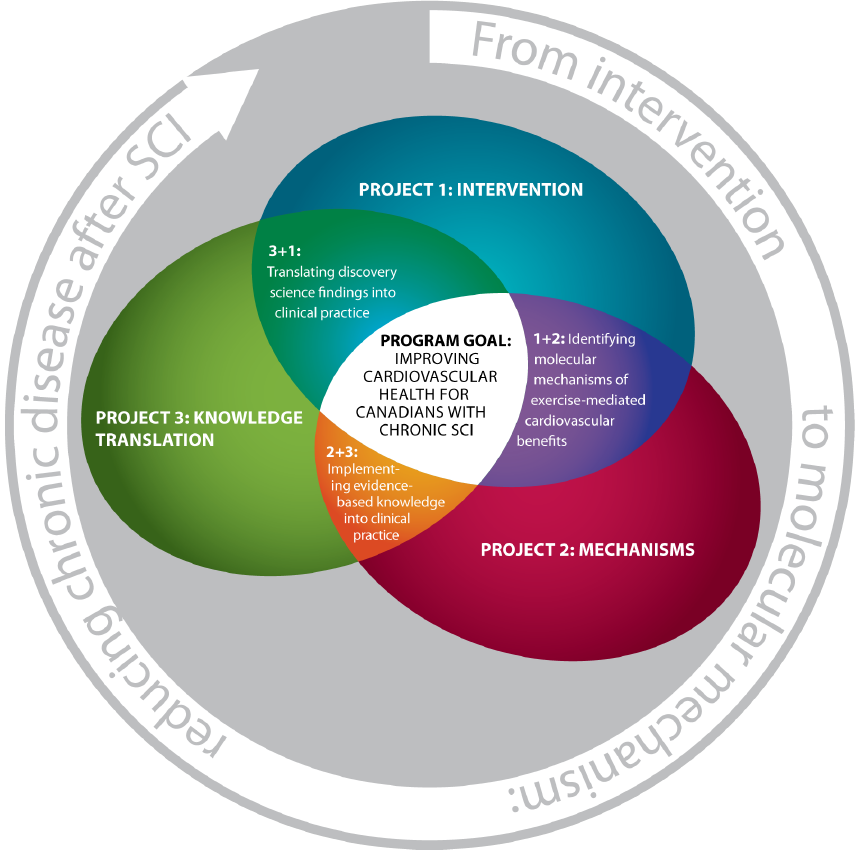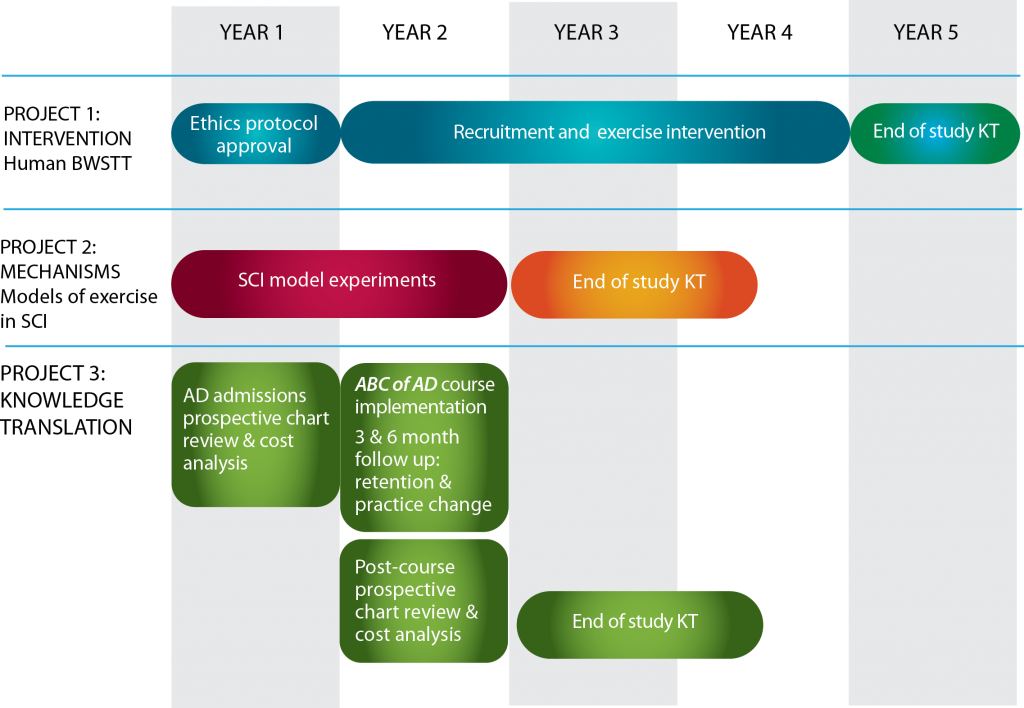THE CHOICES STUDY
Project 1:
Intervention
Looks at the effects of exercise interventions on cardiovascular health of individuals with chronic spinal cord injury. Does the type of exercise – upper – or lower-limb – dictate cardiovascular outcome? Read more
SISTER STUDY
Project 2:
Mechanisms
Using a model of long-term SCI, we will be able to gain an understanding of the mechanisms of cardiovascular dysfunction and the effects of exercise. Read more
SISTER STUDY
Project 3:
Knowledge Translation
Involving the implementation and evaluation of a knowledge translation strategy for enhancing the knowledge and management of autonomic dysreflexia (AD) among paramedics and emergency room staff. The community benefits from more educated health care providers. Read more
THE CHOICES STUDY
Project 1: Intervention
Effects of Exercise Interventions on Cardiovascular Health of Individuals with Chronic Spinal Cord Injury
Does the type of exercise – upper – or lower-limb – dictate cardiovascular outcome?
There are two goals to this research—the first is to compare the fitness benefits of two types of exercise for people with SCI: passive leg exercise using body weight-supported treadmill training (BWSTT) and arm exercise using arm-cycle ergometry training (ACET). This study will use individuals with chronic motor-complete high-thoracic and cervical SCI. The second goal is to look into the economic consequences of the two types of exercise.
In BWSTT, the subject’s body weight and balance are supported by an overhead harness, while therapists manually assist with stepping movements on a treadmill. This approach has previously been used mainly to assist individuals with stroke or incomplete SCI in recovering their ability to walk. However, because it involves a large muscle mass and the cardiovascular challenge of standing, BWSTT also has exceptional potential as a means of exercise for people with complete SCI.
ACET is one of the most popular types of exercise for people with SCI. It involves cycling with the arms, against varying resistance, and for many people with SCI it is the only exercise intervention that can be performed without professional assistance.
In this study, the researchers first will determine basic fitness and metabolic data in all the subjects, who must be individuals with chronic motor-complete high-thoracic or cervical SCI. Next, they will compare the improvements brought about by BWSTT with those due to ACET.
SISTER STUDY
Project 2: Mechanisms
Mechanisms by which Exercise effects Cardiovascular Health in Models of Chronic Spinal Cord Injury
This project will use a model of long-term SCI to gain an understanding of the mechanisms of cardiovascular dysfunction and the effects of exercise. These models will allow us to examine the mechanisms underlying the effects of long-term SCI and exercise interventions on cardiovascular health. Previously, our team has used this technique to characterize vascular dysfunction in models of tobacco exposure and diabetes, and to study the effects of exercise in these models. This project is a unique opportunity to gain bench-to-bedside insight into cardiovascular dysfunction after SCI.
This project aims to establish baseline vascular function and secondary cardiovascular and metabolic measures in models of long-term SCI. We will also evaluate the effects of exercise on vascular function and secondary clinical and molecular outcomes in long-term SCI.
SISTER STUDY
Project 3: Knowledge Translation
Effects of Targeted Education for Health Care Providers on Prevention and Management of Cardiovascular Conditions in Individuals with Chronic Spinal Cord Injury
Does targeted education improve cardiovascular care for individuals with SCI?
This project involves the implementation and evaluation of a knowledge translation (KT) strategy for enhancing the knowledge and management of autonomic dysreflexia (AD) among paramedics and emergency room staff. AD is a life-threatening condition among individuals with high level SCI that occurs daily. Despite the high incidence of the condition medical personnel outside of rehabilitation hospitals remain unfamiliar with AD. Delayed recognition and unmanaged episodes of AD can lead to heart attack, stroke and even death. These outcomes are avoidable if AD is recognized and managed promptly.
This project will translate knowledge that we have generated in previous research including project 1 and 2. Given the urgent need to manage existing problems of cardiovascular dysfunction, and the potential for an immediate impact on the health of people with SCI, this KT strategy will be implemented in the first two years of the research program.
Previously, our team has published a review of research evaluating AD prevention and management strategies. Additionally, in 2010, members of our team evaluated knowledge of AD among emergency health care personnel in three Canadian provinces and found 80% of respondents to rate their AD knowledge as either “Fair” or “Poor” while at least 25% failed to define AD correctly.
This project will establish baseline data on the frequency of admissions and cost of care related to admissions for episodes of AD in four major emergency rooms in three Canadian provinces. Currently there are no Canadian data on these endpoints. Additionally, we will implement and evaluate a multifaceted KT strategy for enhancing knowledge and management of AD among ER physicians, nurses and paramedics.



